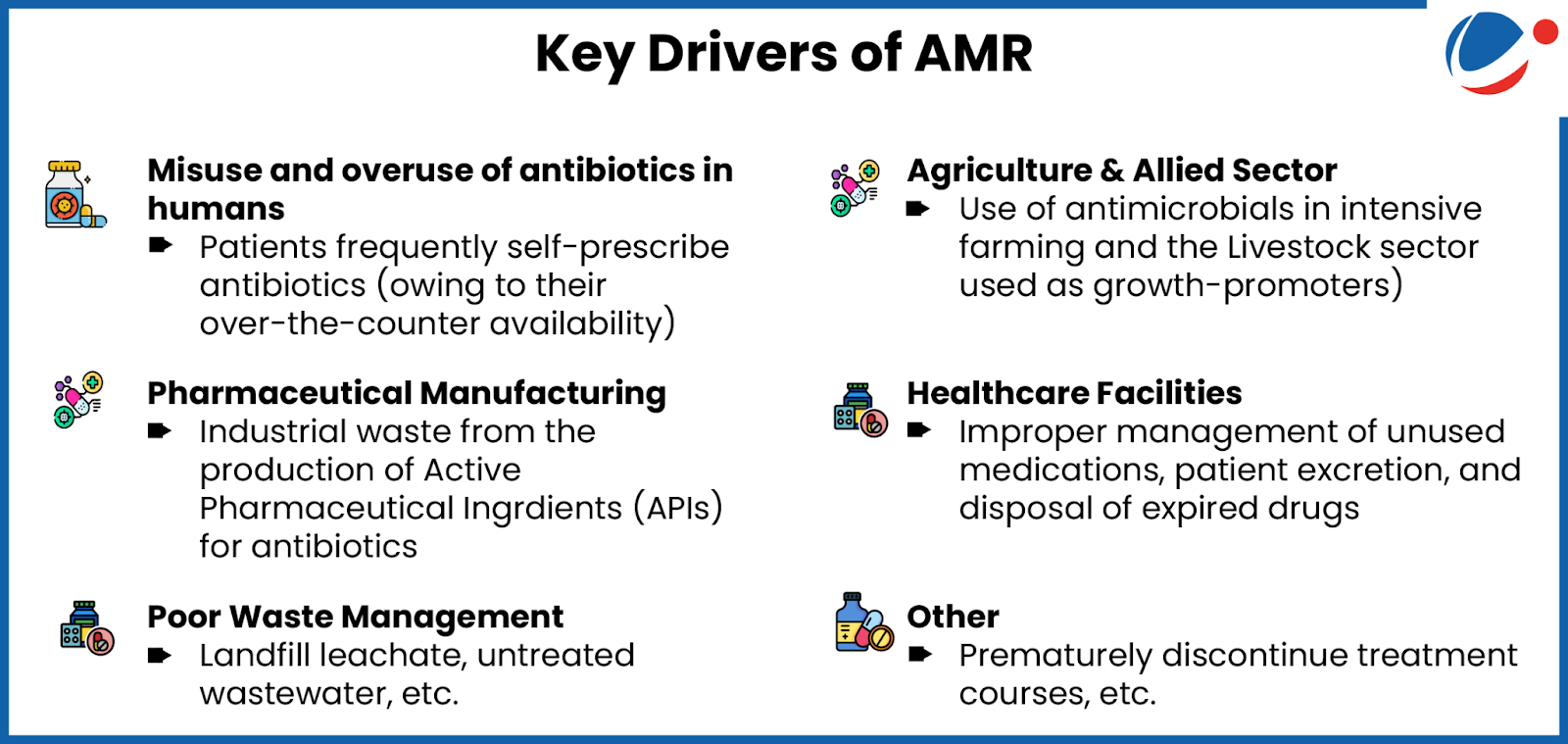NAP-AMR 2.0 (2025–2029) is a sophisticated policy instrument designed to guide India's fight against antimicrobial resistance.
On November 18, 2025, the Union Health Minister launched the National Action Plan on Antimicrobial Resistance 2.0 (NAP-AMR 2.0), marking a major step forward in India's fight against a global health threat. The launch, timed with the World Health Organization's World AMR Awareness Week (November 18-24), signals India's commitment to containing antimicrobial resistance through evidence-based strategies.
Antimicrobial resistance occurs when microorganisms like bacteria and fungi evolve to resist drugs designed to eliminate them, making infections difficult or impossible to treat. This five-year plan (2025-2029) represents an upgrade from the first NAP-AMR launched in 2017, incorporating lessons learned and addressing implementation gaps identified during the initial phase.
Understanding the AMR Crisis
Antimicrobial resistance has emerged as a major public health concern with consequences beyond individual health. AMR poses risks to healthcare interventions including surgical procedures, cancer treatment, and organ transplants. The delays in treatment caused by resistant infections increase healthcare costs while imposing economic burdens on families and society.
The latest report by World Health Organization (WHO) shows that one in every six bacterial infections globally was resistant to antibiotics, with India being one of the biggest contributors to this alarming pattern of antimicrobial resistance (AMR). India's journey in addressing AMR began with preliminary discussions in 2010, followed by the development of a National Policy on AMR containment in 2011.

The first National Action Plan on Antimicrobial Resistance was launched in April 2017, designed for implementation over five years (2017-2021). While this initial plan established the foundational framework, its effectiveness was hampered by coordination challenges between ministries, limited private sector engagement, and gaps in ownership of AMR-related efforts.
India's Pioneer Role in Global AMR Action
India is one of the pioneers in driving the fight against AMR globally. Several progressive steps demonstrate this leadership:
- Regulatory Measures: Kerala and Gujarat became the first states to ban over-the-counter sales of antibiotics, setting a precedent for rational antibiotic use.
- Agricultural Controls: Certain antimicrobials and pesticides have been banned for use in crops, reducing environmental contamination and selection pressure.
- Innovation Platform: The India AMR Innovation Hub was established involving both national and international stakeholders to build a novel technology platform. This hub has proven instrumental in mobilizing resources, fostering innovation, and enhancing collaboration between multiple stakeholders.
Key Features of NAP-AMR 2.0
The updated plan introduces enhancements designed to overcome the limitations of its predecessor. NAP-AMR 2.0 is built on six interconnected core objectives that provide a systemic response to antimicrobial resistance containment.
- Awareness, Education, and Training: The plan prioritizes improving public understanding of AMR through communication campaigns and professional training programs. Recognizing that behavior change is fundamental to success, this pillar targets healthcare professionals, veterinarians, farmers, and the general public.
- Surveillance and Laboratory Capacity: Strengthening laboratory networks for AMR detection remains critical. The plan expands surveillance capabilities and introduces targeted monitoring of antibiotic residues in environmental samples, particularly wastewater from hospitals, agricultural farms, and pharmaceutical industries.
- Infection Prevention and Control (IPC): Reducing the incidence of infections through IPC measures in all healthcare facilities serves as a proactive strategy. Better infection control means fewer infections requiring antibiotic treatment, thereby reducing selection pressure for resistance.
- Antimicrobial Stewardship (AMS): Optimizing antimicrobial use across human, animal, and food sectors ensures judicious consumption while maintaining uninterrupted access for those who need these life-saving medicines.
- Research and Innovation: The plan promotes both basic scientific research and operational studies relevant to AMR, supporting the development of new diagnostics, therapeutics, and implementation strategies.
- Governance and Coordination: NAP-AMR 2.0 elevates governance to a standalone pillar, acknowledging that institutional coordination is vital for successful implementation of the plan.
Enhanced Accountability Mechanisms
A distinguishing feature of NAP-AMR 2.0 is its accountability structure. The plan mandates that each of the over 20 key stakeholder ministries and departments develop action plans with defined timelines and dedicated budgets. This shifts the approach from cooperation to enforceable, quantifiable accountability.
The updated plan also includes mechanisms for coordination and collaboration both within and across sectors. Regular stakeholder meetings have been institutionalized to address implementation challenges, ensuring that momentum is maintained throughout the five-year timeline.
One Health Approach: Integrating Multiple Sectors
Central to NAP-AMR 2.0 is the operationalization of the One Health approach, recognizing that AMR is a problem transcending sectoral boundaries. The plan links efforts across human health, animal health, agriculture, and the environment, aligning with the Global Action Plan on AMR developed by the Food and Agriculture Organization (FAO), WOAH (World Organisation for Animal Health), World Health Organization (WHO), and United Nations Environment Programme (UNEP).
Human Health Sector
The Ministry of Health and Family Welfare, through institutions like the National Centre for Disease Control (NCDC) and the Indian Council of Medical Research (ICMR), maintains surveillance networks. ICMR operates an AMR Surveillance network encompassing 30 hospitals and laboratories, providing data on multidrug resistance patterns in common pathogens.
Animal Health and Agriculture
The animal health sector addresses challenges including emerging livestock diseases and zoonotic pathogen linkages. Institutions like the National Dairy Research Institute (NDRI) of the Indian Council of Agricultural Research (ICAR) have developed Point-of-Care diagnostics for conditions like mastitis in cattle, enabling rapid diagnosis and reducing unnecessary antibiotic use.
The plan emphasizes collaboration to implement "Diagnostic One Health Solutions" for early detection and proper management of livestock diseases, particularly in resource-constrained settings where laboratory results are often delayed.
Environmental Surveillance
Acknowledging the environment as a significant reservoir for AMR, NAP-AMR 2.0 mandates enhanced surveillance of antimicrobial resistance and residues in wastewater from three high-risk sources: hospitals, agricultural farms, and pharmaceutical industries. This strategic intervention moves policy beyond clinical and veterinary stewardship into industrial environmental regulation.
Conclusion
The launch of NAP-AMR 2.0 represents India's commitment to preserving the efficacy of modern medicine through systematic, accountable, multi-sectoral action. As the Minister of Health and Family emphasized, antimicrobial resistance can only be addressed through collective action involving all stakeholders.
The plan provides a sophisticated policy framework with enhanced governance structures, comprehensive One Health integration, and rigorous accountability mechanisms. Its transformative potential depends on sustained political commitment, adequate financial resources, and effective coordination across all sectors. By addressing AMR comprehensively, India not only protects its own population but also contributes significantly to global health security.

Master Digital Age Governance & Technology Trends with VisionIAS Comprehensive Current Affairs →
FAQs on National Action Plan on Antimicrobial Resistance 2.0
1. What is NAP-AMR 2.0?
Ans. India's updated action plan to combat antimicrobial resistance from 2025-2029.
2. What does antimicrobial resistance mean?
Ans. Microorganisms evolving to resist drugs designed to eliminate them.
3. Which approach does NAP-AMR 2.0 follow?
Ans. One Health approach.
4. Which Indian states banned over-the-counter antibiotic sales first?
Ans. Kerala and Gujarat.
5. What is the India AMR Innovation Hub?
Ans. A platform for developing novel technologies to combat antimicrobial resistance.